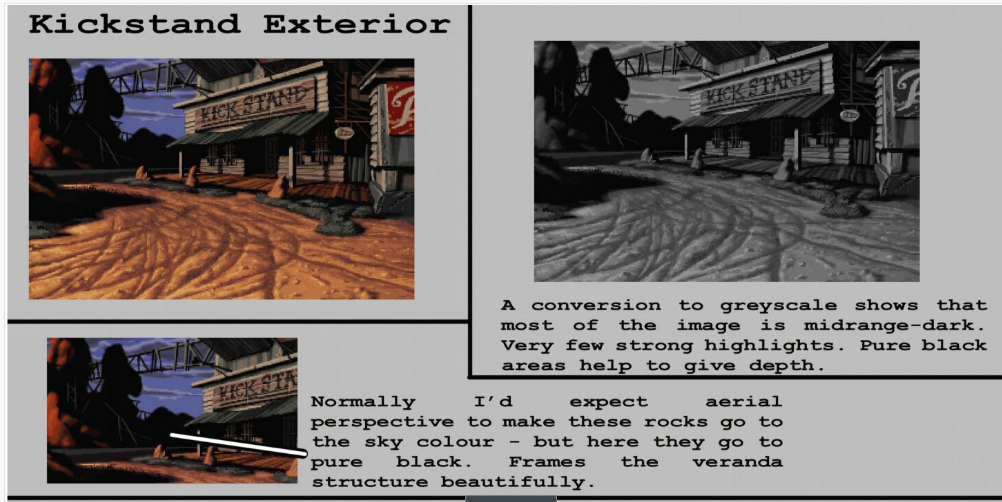This week’s critical writing changed my understanding of how games connect to the physical world and to urban life. Let’s go on a little wander through the winding paths of online discourse.

Visuals and sound
Slightly stepping away from our overwhelming reliance on text for critical communication, in these pieces critics use sound and visuals to explore games.
- 304: Full Throttle Scenery Studies
Ben Chandler carried out another in-depth visual analysis of point-and-click adventure sceneries, this time compiled into a PDF. - Waypoint Rescores: ‘Life Is Strange’ – Waypoint
Mike Diver engages in an experiment involving critical remixing of game audio. - A Photographer Chronicles The Alien Beauty of ‘Horizon Zero Dawn’ – Waypoint
Don Saas’s writing reveals how game photography can function as a critical practice.
“the player, and even entire areas—are dwarfed by the vastness of its deserts and plains, the suffocating thickness of its forests, and the titanic mountains that encircle you. My photos were almost all landscapes with a few shots of decrepit buildings rising out of jungles and frozen tundras. The game is at its most transcendent and awe-inspiring when you feel as Aloy likely would: utterly lost in a world so much bigger and older than she could ever imagine.”
Interpenetrating the world
The wilds and the cities have critics fascinated this week, as in-depth examinations of game spaces encompass all genres.
- Breath of the Wild’s Quiet Guidance and the Lessons of the Great Plateau | Elite Review
Evan Conley leads us through a focused exploration of how a particular Zelda level frames player experience and narrative. - Opened World: Walled City – Haywire Magazine
Miguel Penabella analyses the architecture of contemporary China as represented in Kane and Lynch. - The Endless Light and Hunger of Cities in Games – Waypoint
Chris Priestman discusses modes of expression less concerned with realism and more with capturing certain impressions and atmospheres associated with urbanization. - Pokemon Go is a mass demon summoning that’s destroying our reality | ZAM – The Largest Collection of Online Gaming Information
John Brindle discovers hidden forces more powerful than any game developer may have dared imagine.
“Niantec created an invisible force field interpenetrating the world which drove changes in that world which might otherwise seem inexplicable. But don’t take my word for it: the reason I bring up occultism is because Ingress’ marketing leaned heavily into such ideas.”
Kneel by the body
Eurogamer have done some compelling work this week on the social relationships that exist around games, with a particularly remarkable interest in how people relate to each other in the physical world.
- Beyond the pitch: How FIFA is influencing youngsters away from the TV • Eurogamer.net
Craig Shields interviews coaches and teachers to investigate the impact of FIFA on children’s performance in football clubs on the ground. - 20 years on, Bushido Blade remains a fighting game masterpiece • Eurogamer.net
Simon Parkin remembers the solemnity and good humour of couch combat.
“Rather than linger on the violence, however, Lightweight takes a respectful, thoughtful approach. No screaming guitars or yowling choir to back the drama. There is almost no soundtrack to fights, and instead there’s a silence, one that is made all the louder by these pastoral settings. After each fight, your character will typically kneel by the body of the person whose life they’ve taken, before issuing a mournful soliloquy.”
Real human behavior
These two pieces uncover new ways of understanding the involvement of politics and governance in gaming.
- Making political videogames may not work. But we have to try | ZAM – The Largest Collection of Online Gaming Information
John Brindle uses GDC microtalks as touchstones to argue that there are other ways of seeing political interventions in games than Asi Burak’s notion of the US President as “gamer in chief” - The CIA uses board games to train officers—and I got to play them | Ars Technica
Sam Machkovech finds in CIA game design a particular valorization of people’s ability to learn systems from the inside out.
“That’s real human behavior,” CIA Chief Strategy Officer Rachel Grunspan says. “If you design a game right, you’ll see a lot of complexity organically emerge. That’s what you want.”
The pain of everyday life
Finally, this last little bunch of pieces examines the different character roles we can play and interpret in games.
- ‘Leaving Lyndow’ Is a Game About the Hardship of Preparing for Adventure – Waypoint
Reid McCarter makes a great argument about the potential uses of games as a form for understated expression, through a reading of one recent example. - Another Journey: A Reflection on Togetherness, Protection, and Crying on a Livestream – Not Your Mama’s Gamer
Jynx Boyne discusses the identity positions encoded in the costumes of Journey. - COLE PHELPS | shutupvideogames
Ed Smith argues for more imperfect protagonists in games.- “If escapism is intended to alleviate the pain of everyday life or mundane experience, there is nothing more soothing than seeing, on a screen, our pain articulated and understood by another human being – it lets us know that the things we suffer are not our’s alone to bear”
Subscribe
Critical Distance is community-supported. Our readers support us from as little as one dollar a month. Would you consider joining them?
Contribute
Have you read, seen, heard or otherwise experienced something new that made you think about games differently? Send it in!


